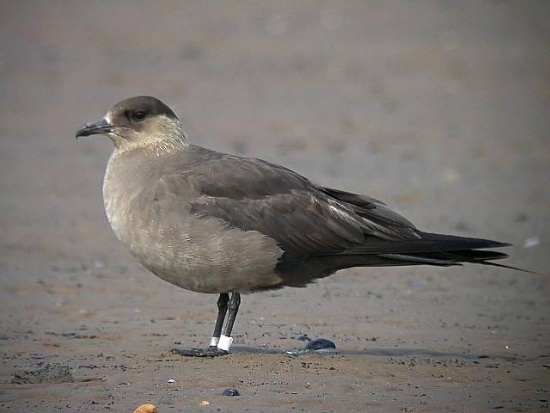- Stercorarius parasiticus
Photographed at Cleveland, UK
Identification
Also known as Arctic or Parasitic Skua
Identification of this skua is complicated by its similarities to Long-tailed Skua and Pomarine Skua, and the existence of three colour phases. This is one of the smaller skuas at about 41 cm length, excluding the pointed central tail feathers of the summer adult, which can add another 7 cm or so. Light phase adults have a brown back, mainly white underparts and dark primary wing feathers with a white "flash". The head and neck are yellowish-white with a black cap and there is a pointed central tail projection. Dark phase adults are dark brown, and intermediate phase birds are dark with somewhat paler underparts, head and neck. All phases have the white wing flash.
Juveniles are even more problematic, and are difficult to separate from Long-tailed Skua over the sea. They are bulkier, shorter-winged and less tern-like than that species, but show the same wide range of plumage variation. The flight is more falcon-like. However, they are usually warmer toned than Long-tailed, with browner shades, rather than grey.
Parasitic Jaeger Dark: Medium-sized jaeger with brown body, darker cap, and pale underwing patches near tips. Diamond-shaped tail has elongate, pointed central feathers. Pale form has white underparts with brown breast band; intermediates between dark and light forms occur. Sexes are similar. Juveniles of both forms are brown-barred overall and have dark-tipped bills and slightly elongated central tail feathers.
Distribution
Breeds on coasts of Alaska, as well as coastal and inland tundra regions of northern Canada; also found in Greenland, Iceland, Scandinavia, and northern Russia. Spends winters on tropical oceans of the southern hemisphere.
Taxonomy
Habitat
It nests on dry tundra, higher fells and islands.
Behaviour
It lays up to four olive-brown eggs. It is usually silent except for newing and wailing notes while on the breeding grounds. Like other skuas, it will fly at the head of a human or fox approaching its nest. Although it cannot inflict serious damage, it is a frightening and painful experience. It is a migrant, wintering at sea in the tropics and southern oceans.
This bird will feed on lemmings and other rodents on the breeding grounds, but also robs gulls and terns of their catches. Like the larger skua species, it continues this piratical behaviour throughout the year, showing great agility as it harasses its victims.
Jizz and behaviour-based ID tips [[1]]
Bird Song
<flashmp3>Stercorarius parasiticus (song).mp3</flashmp3>
Listen in an external program




